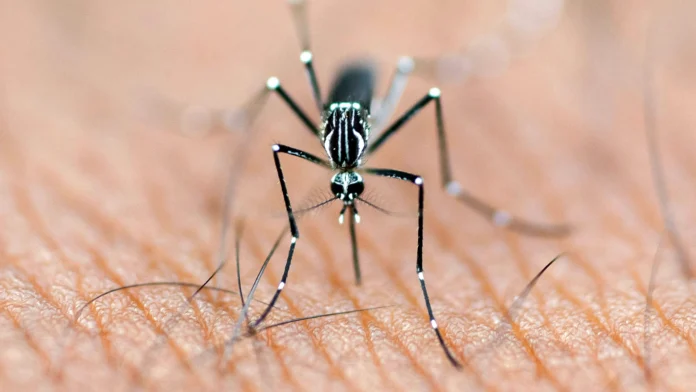by Maria Jose Diaz-Gutierrez, MD and Aileen Chang, MD
In a world where infectious threats evolve faster than our responses, the greatest strength of modern medicine may not lie in high-tech treatments, but in the simple and powerful act of prevention. Vector-borne diseases like Chikungunya remind us that sometimes the best defense is not to wait for the battle to begin, but to make sure it never does.
With this in mind, it is urgent to reconsider the role of prevention as a cornerstone of public health. Instead of focusing only on treating diseases and their complications, we need to strengthen actions that stop them from happening in the first place. Tropical infections like Chikungunya are no exception. This virus, spread by mosquitoes, is one of the most common vector-borne diseases worldwide. Around 5 million cases are reported every year, and three-quarters of the global population live in areas at risk of infection1. On top of that, there is no specific antiviral treatment, which makes its control even harder. Because of this, non-pharmacological strategies like community education are key to preventing its spread.
However, prevention should not be limited to education or environmental measures. Scientific progress has brought new hope with the development of vaccines, which are a powerful tool to reduce the impact of these diseases. Currently, the chikungunya vaccine is recommended for people traveling to or taking residence in endemic areas. One of the most affected groups that should be focused on for vaccination is women.
A special focus on women for vaccination, especially those of childbearing age who want to become pregnant, would be a smart and effective move. Mother-to-child transmission can happen in any trimester of pregnancy, but when it occurs around the time of birth, it can lead to serious outcomes like neonatal death or long-term neuro-disabilities requiring intensive care2.
Some studies have reported that the risk of vertical transmission of Chikungunya virus is around 50% when the mother has a high viral load at the onset of labor. Neither delaying vaginal delivery nor performing a cesarean section appears to reduce the risk of fetal infection3.
The currently approved vaccines have shown an acceptable safety profile and strong immune response in participants under age sixty-five, which supports its use as part of prevention strategies for women before conception4. This is why education and vaccination (our guardians of tomorrow) must stand at the front line, not only protecting lives, but shaping a future where tropical diseases are no longer a threat, but a lesson from the past.
Furthermore, women are also at higher risk of developing chronic chikungunya arthritis. Multiple studies consistently report a higher prevalence of chronic Chikungunya arthritis among women. In a Thai cohort study, 78% of patients with persistent arthritis beyond three months were female, and female sex was an independent predictor of chronic disease (OR 4.17, 95% CI 1.05–16.7)5. Similarly, a cohort study from Martinique found that female sex significantly associated with chronic arthritis at 12 months (p = 0.04)6. In a Colombian cohort, 89% of the those with chronic arthritis were female7. These findings are further supported by a systematic review which consistently identified female sex as a key risk factor for chronic chikungunya arthritis alongside older age and severe acute disease8.
Collectively, these data indicate a clear gender disparity in the burden of chronic Chikungunya arthritis, suggesting a potential role for sex-based differences in immune response or hormonal regulation. Clinicians should be aware of this gender bias when counseling patients in the chronic arthritis risk and vaccination as a prevention tool.
Vaccination is not merely a tool—it is a transformative force in the prevention of tropical diseases like Chikungunya. As we face rising case numbers and expanding transmission zones, especially in the context of climate change, prioritizing prevention becomes not just wise, but necessary. Focusing on women—who bear a disproportionate burden of both acute and chronic disease—offers a strategic and ethical path forward. By integrating vaccination into reproductive health planning and emphasizing education in high-risk regions, we can empower communities and protect future generations. In doing so, we reaffirm that the true guardians of tomorrow are not only the scientists and clinicians developing these tools, but the individuals and families who choose prevention, safeguarding health before illness takes hold.
References:
(1) Bettis, A. A.; L’Azou Jackson, M.; Yoon, I.-K.; Breugelmans, J. G.; Goios, A.; Gubler, D. J.; Powers, A. M. The Global Epidemiology of Chikungunya from 1999 to 2020: A Systematic Literature Review to Inform the Development and Introduction of Vaccines. PLoS Negl. Trop. Dis. 2022, 16 (1), e0010069. https://doi.org/10.1371/journal.pntd.0010069.
(2) Contopoulos-Ioannidis, D.; Newman-Lindsay, S.; Chow, C.; LaBeaud, A. D. Mother-to-Child Transmission of Chikungunya Virus: A Systematic Review and Meta-Analysis. PLoS Negl. Trop. Dis. 2018, 12 (6), e0006510. https://doi.org/10.1371/journal.pntd.0006510.
(3) Ferreira, A. S.; Baldoni, N. R.; Cardoso, C. S.; Oliveira, C. D. L. Biomarkers of Severity and Chronification in Chikungunya Fever: A Systematic Review and Meta-Analysis. Rev. Inst. Med. Trop. Sao Paulo 2021, 63, e16. https://doi.org/10.1590/S1678-9946202163016.
(4) Rosso, A.; Flacco, M. E.; Cioni, G.; Tiseo, M.; Imperiali, G.; Bianconi, A.; Fiore, M.; Calò, G. L.; Orazi, V.; Troia, A.; Manzoli, L. Immunogenicity and Safety of Chikungunya Vaccines: A Systematic Review and Meta-Analysis. Vaccines 2024, 12 (9), 969. https://doi.org/10.3390/vaccines12090969.
(5) Yodtaweepornanan, P.; Pongsittisak, W.; Satpanich, P. Incidence and Factors Associated with Chronic Chikungunya Arthritis Following Chikungunya Virus Infection. Trop. Med. Int. Health TM IH 2023, 28 (8), 653–659. https://doi.org/10.1111/tmi.13906.
(6) Bertolotti, A.; Thioune, M.; Abel, S.; Belrose, G.; Calmont, I.; Césaire, R.; Cervantes, M.; Fagour, L.; Javelle, É.; Lebris, C.; Najioullah, F.; Pierre-François, S.; Rozé, B.; Vigan, M.; Laouénan, C.; Cabié, A. Prevalence of Chronic Chikungunya and Associated Risks Factors in the French West Indies (La Martinique): A Prospective Cohort Study. PLoS Negl. Trop. Dis. 2020, 14 (3), e0007327. https://doi.org/10.1371/journal.pntd.0007327.
(7) Chang, A. Y.; Encinales, L.; Porras, A.; Pacheco, N.; Reid, S. P.; Martins, K. A. O.; Pacheco, S.; Bravo, E.; Navarno, M.; Rico Mendoza, A.; Amdur, R.; Kamalapathy, P.; Firestein, G. S.; Bethony, J. M.; Simon, G. L. Frequency of Chronic Joint Pain Following Chikungunya Virus Infection: A Colombian Cohort Study. Arthritis Rheumatol. Hoboken NJ 2018, 70 (4), 578–584. https://doi.org/10.1002/art.40384.
(8) van Aalst, M.; Nelen, C. M.; Goorhuis, A.; Stijnis, C.; Grobusch, M. P. Long-Term Sequelae of Chikungunya Virus Disease: A Systematic Review. Travel Med. Infect. Dis. 2017, 15, 8–22. https://doi.org/10.1016/j.tmaid.2017.01.004.
- Dr. Maria Jose Diaz-Gutierrez, MD, is a Colombian physician and co-investigator in clinical trials in infectious diseases, cardiology, and vaccines. She has worked on studies involving emerging infections and vaccine-preventable diseases. Her main interests include tackling health disparities across Latin America through research in infectious and chronic diseases. She is passionate about linking clinical care with research to improve outcomes in underserved populations and contribute to global health efforts.
- Dr. Aileen Chang, MD, MSPH received her MD from Columbia University and trained in Internal Medicine and Public Health at the University of Miami. She is an Associate Professor of Medicine and Microbiology at George Washington University and a clinical translational arboviral researcher.







